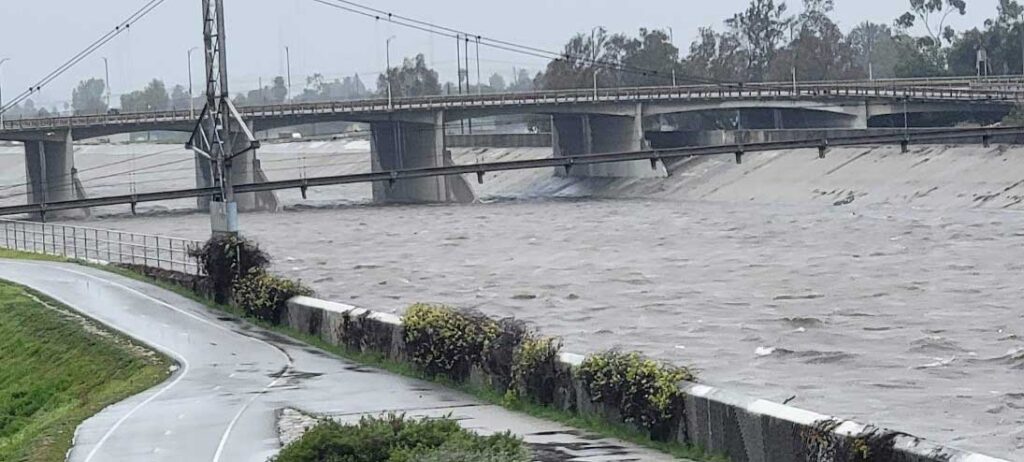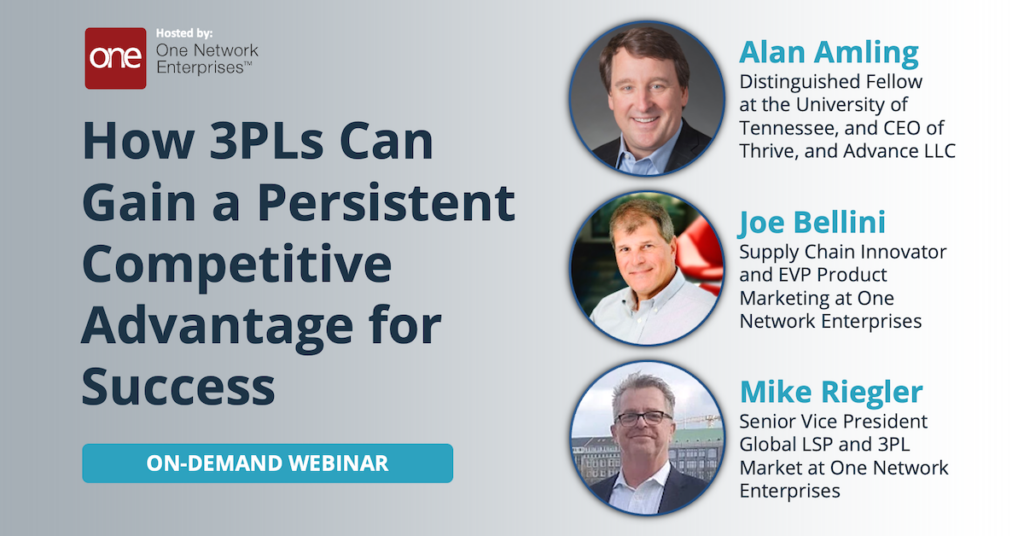This post has already been read 14243 times!
Fear and loathing at TPM Tech / TPM23
My recent travels and attending conferences like Manifest and TPM Tech/TPM23, have reinforced my observations about, and enthusiasm for, the 3PL sector and where it is going. Most recently, TPM provided added proof and inspiration, that many of the brightest minds in the global shipping sector are serious about breaking out of the traditional boxes many technology solutions impose on us, and are thinking big. Supply chain network big.
This year marked the second post-Covid return of the conference. The JOC did an outstanding job creating a program that brought together the many stakeholders of this ecosystem together who find ocean shipping and global supply chains in our blood.

As part of TPM, we can normally anticipate good use of our sunglasses and golf clubs. This year, however, SoCal’s atmospheric river (see photo) had other ideas for us. Glad I brought my golf clubs, though, as I needed something to step over in my hotel room – Doh!

“There was madness in any direction, at any hour. You could strike sparks anywhere. There was a fantastic universal sense that whatever we were doing was right, that we were winning.”
Hunter S. Thompson, Fear and Loathing in Las Vegas
Both TPMTECH and TPM23 conference themes, Navigating the Land of Confusion and Picking up the Pieces, respectively, captured the exhaustion, frustration, and chafe that we all experienced moving through the nastiness and chaos brought on by the pandemic. Even as we gathered this year with transportation rates in sharp decline, no one was in a relaxed state of mind. None of that – we all know better.
The Big Question Everyone Was Asking
In fact, I noticed that there was only question that mattered during both events. Whether it was the last point raised at the end of each agenda session or whether it was the top of mind topic across the numerous conversations that ensued before, during, and after hours at both conferences, we all want to know one thing:
Are you ready for another great surge and more rounds of disruption and chaos?
My career started with and now runs with the Logistics Service Provider (LSP) industry as I lead my company’s global LSP/3PL business. I have seen things and know things. What I know for sure is that all of us in supply chain live for this stuff and these times. I often refer to Dr. Hunter S. Thompson’s gonzo mantra from his book, Fear and Loathing on the Campaign Trail ’72, almost as if he were manning a global LSP customer solution desk himself:
When the going gets weird, the weird turn professional.
We just ain’t 9-5 folk – never have been.
This is why I paid keen attention to the answers as I heard this question raised. While I noticed a range in replies, two common themes did, in fact, emerge.
First, the softening transport rates is only a lull – the propensity for disruption remains high and is lurking and ready to erupt.
Second, we are, indeed, ready to respond.
Aligned to the first point, Julie Gerdeman, CEO of Everstream Analytics, started her keynote address at TPM Tech reminded us, “Reinforcements are not coming.” She further added, “Being ‘reactive’ is not a sustainable path forward.”
On the second point, Tim Scharwath, CEO of DHL Global Forwarding, in his lead off session at TPM23, stated, “Global LSPs are quite happy when supply chains are in chaos and their customers rush to ask them, ‘what can you do for me?’”
Of course, we are ready – it is what we always have done in supply chain.
"Global LSPs are quite happy when supply chains are in chaos. Their customers rush to ask them: 'What can you do for me?'" -Tim Scharwath, CEO, DHL Global Forwarding Share on XMy big TPMTECH and TPM23 takeaways
In the face of supply chain disruptions including the pandemic, many initiatives have been launched including Risk Management, 24/7 Port Operations, and FLOW.
In the sessions that included these topics separately, each presenter emphatically stressed the fundamental point that these initiatives require more than a Eureka moment to mark their success. When addressing a risk management related question about why no one saw the COVID pandemic and related surge coming, Ms. Gerdeman pointed out, “There will always be the very unusual suspects that cause disruption. The key is to set the dials on a process framework for high value uses cases that drive the execution to quick (er) resolution.”
There will always be very unusual suspects that cause disruption. The key is to set the dials on a process framework for high value use cases that drive the execution to quicker resolution." -Julie Gerdeman, CEO Everstream Analytics Share on XSimilarly, in the How to Improve Container Flow Through Terminals session, Beth Ann Rooney from the Port Authority of New York and New Jersey, reminded us that the Port of New York did open on Saturdays; however, only 4% of the available containers were picked up adding $33,000 incremental cost to each of those containers. For Ms Rooney, the Eureka moment of 24/7 port and terminal operations was ineffective to address the backlogs because there was no “24/7 framework beyond the ports” to keep the containers moving.
In The State of FLOW: An Analysis of North American Port Efficiency session, Stephen Lyons, Retired Gen. White House Special Envoy for Ports and Supply Chains, added that “24/7” and other initiatives to keep cargo moving make perfect senses when they include the framework that smooths out the linkages across the supply chain. Otherwise, we just have more buildings at terminals.
Without these frameworks to bring the discoveries and the promise of innovation to full implementation and action, these initiatives will lead only to audible echoes of those crying out Eureka rather than the constant hum of solutions delivering effectiveness and responsiveness.
Secondly, it’s great to observe that the partnership discussions and pursuits for LSPs and their customers are much more focused now on an end-to-end solution scope, rather than staying within the stubborn boundaries of transportation functional and transactional capabilities.
As an example of this development, Reade Kidd, EDRAY CEO and Co-Founder, pointed out In the Innovative Solutions for Managing Complex Import Delivery Networks: A Big Lots Case Study session, “EDRAY’s container offload – container return service lifecycle includes seven processes and their stakeholders.” In the end, being able to manage this full end-end scope at destination was the key for EDRAY’s success and value it created for their customer, Big Lots.
"Network platforms that connect multiple stakeholders and systems will provide recipe for supply chain resilience going forward." | Global LSPs & 3PLS Embrace the Chaos and Turn Professional Share on XI encountered other such tales where the end-end scope of the problem and the solution were the priority. This positive shift in frame beyond the transaction movement of containers will ultimately lead to bigger financial and sustainability partnership outcomes.
Finally, my last TPM23 discussion connected me with an old colleague who is one of the most innovative minds in the global LSP space. Always a lively chat, we discussed how the classic transaction operational excellence and customer service are no longer good enough for LSP customers. He stated clearly that customer demands that he hears are now, “What is your ability to connect my network and how can you take me beyond the current scope?” In a follow-up point he added, “Network platforms that connect multiple stakeholders and systems will provide recipe for supply chain resilience going forward.”
Innovative Leaders in are Embracing Digital Supply Chain Networks
In conclusion, I am genuinely impressed with how the global supply chain solution discussion is moving past the hype of niche Eureka moments and finite transaction-based outcomes.
However, more push is needed to ensure that the impact range of these advances is not shortchanged or restricted. Therefore, forward-thinking innovation leaders in the supply chain space from global shippers, the LSPs, and technology providers, must now focus on how to fully connect the solution frameworks such as those mentioned above, and to expand the end-end process capabilities to drive widespread optionality across supply chain networks of global shippers.
At network scale, we can begin to think of a company’s persistent advantage to constantly produce financial and sustainability goals even in the most disruptive environments. Only then will we be truly ready for the next surge.

Recommended Posts
- Are Micro Fulfillment Centers the Next Frontier in Retail Logistics?
- Rethinking Defense Supply Chains with Network-Based Command Centers
- How to Use Predictive Analytics to Streamline Cross-Border Logistics
- AI Plus Humans for Resilient Freight Forwarding in a Complex World
- Modern Defense Supply Chains: The Essential Capabilities for Multi-Domain Operations
- Global LSPs and 3PLs Embrace the Chaos and Turn Professional - May 18, 2023
- My Top 3 Takeaways from Manifest 2023 - February 14, 2023
